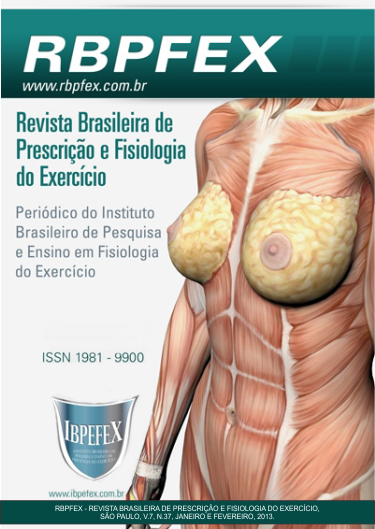Elderly perceived exertion in family fitness zones
Abstract
Introduction: Installation of Family Fitness Zones (FFZ) is one of public policies that aimed to encouraging physical activity in the elderly population. To obtain the benefits of regular exercise, however, a minimum intensity is required. Objective: The purpose of this study was to identify the level of perceived exertion (PE) in FFZ exercises by the elderly. Materials and Methods: 21 elderly people were interviewed and asked to point the PE at the Borg scale at the end of each exercise. The data were processed using descriptive statistic, Pearson correlation and Student’s test-t. Results: The most performed exercises in the FFZ were the Hiking Simulator, Skiing ant the Leg Press, followed by Rowing Simulator, Riding Simulator and Shoulder Press. The average PE per exercise ranged from 10,7 to 12,8, and the reported exercise session average was 11,6. Discussion: The literature recommends a PE between 12 and 13 to this population, considering individuals limitations. All exercise caused a PE within this range or slightly below. Conclusion: The exercises available in the FFZ are sufficient to stimulate a more active way of life and also to generate the elderly fitness.
References
-American College of Sports Medicine. ACSM Current Comment Perceived Exertion. http://www.acsm.org. 2012. Acessado em 15/09/12.
-American College of Sports Medicine. Exercise and physical activity for older adults. Official Journal of the American College of Sports Medicine. http://www.acsm-msse.org. 2009. p. 1510 a 1530. Acessado em 18/09/12.
-Assumpção, C. O.; Pellegrinotti, I.; Neto, J. B.; Montebelo, M. I. L. Controle de intensidade progressiva de exercícios localizados em mulheres idosas por meio da percepção subjetiva de esforço (Borg). Revista da Educação Física/UEM. Maringá. Vol. 19. Núm. 1. 2008. p. 33-39.
-Assumpção, C. O.; Souza, T. M.; Urtado, C. B. Treinamento resistido frente ao envelhecimento: uma alternativa viável e eficaz. Anuário da Produção Acadêmica Docente. Vol. 2. Núm. 3. 2009. p. 451-476.
-Cohen, D. A.; Marsh, T.; Williamson, S. Golinelli, D. McKenzie, T. L. Impact and cost-effectiveness of family Fitness Zones: A natural experiment in urban public parks. Revista Health & Place. Núm. 18. 2012. p. 39-45.
-Costa, A.; Fernandes, C. Utilização da percepção subjectiva do esforço para monitorização da intensidade do treino de força em idosos. Revista Motricidade Vol. 3. Núm. 2. 2007. p. 37-46.
-Day M. L., McGuigan M. R., Brice G., Foster C. Monitoring exercise intensity during resistance training using the session RPE scale. Journal of Strength and Conditioning Research. Vol. 18. Núm. 2. 2004. p. 353-358.
-Esteves, J. V. D. C. ; Andreato, L. V.; Pastório, J. J.; Juliana, Versuti, K. B.; Almeida, H. C.; Moraes, S. M. F. O uso de academias da terceira idade por idosos modifica parâmetros morfofuncionais ?Acta Scientiarum. Health Sciences Maringá. Vol. 34. Núm. 1. 2012. p. 31-38.
-Farinatti, P. T. V. Envelhecimento, promoção da saúde e exercício: bases teóricas e metodológicas. São Paulo. Manole. 2008.
-Kruchelski, S.; Grande, D.; Wendling, N. M. S. Utilização do Ambiente Construído: Academias ao Ar Livre em Curitiba.Revista Gestão Pública em Curitiba. Vol. 2. Núm. 2. 2011. p. 67-80.
-McKenzie, T.L., Cohen, D.A., Sehgal, A., Williamson, S., Golinelli, D. System for Observing Parks and Recreation in Communities (SOPARC): reliability and feasibility measures. Journal of Physical Activity and Health. Núm. 3. 2006. p. 208-222.
-Prefeitura Municipal de Curitiba. Secretaria Municipal do Esporte, Lazer e Juventude. Academias ao ar livre. 2012a. Disponível: http://www.curitiba.pr.gov.br/conteudo/academia-ao-ar-livre-smel-secretaria-municipal-do-esporte-lazer-e-juventude/144. Acesso em 22/09/12.
-Prefeitura Municipal de Curitiba. Secretaria Municipal do Esporte, Lazer e Juventude. Centro de Referência Qualidade de Vida e Movimento Professor Nelson Lopes Pereira. 2012b. Disponível:http://www.curitiba.pr.gov.br/conteudo/centro-de-referenca-qualidade-de-vida-e-movimento-smelj-secretaria-municipal-do-esporte-lazer-e-juventude/147. Acesso em 22/09/12.
-Queiroz, A. C. C.; Kanegusuku, H. Forjaz, C. L. M. Efeitos do treinamento resistido sobre a Pressão Arterial de idosos. Arquivo Brasileiro de Cardiologia. Vol. 95. Núm. 1. 2010. p. 135-140.
-Silva, T. A. A.; Junior, A. F.; Pinheiro, M. M.; Szejnfeld, V. L. Sarcopenia Associada ao Envelhecimento: Aspectos Etiológicos e Opções Terapêuticas. Revista Brasileira de Reumatologia, Vol. 46. Núm. 6. 2006. p. 391-397.
-Tiggemann, C. L.; Pinto, R. S.; Kruel, L. F. M. A Percepção de Esforço no Treinamento de Força. Revista Brasileira de Medicina do Esporte. Vol. 16. Núm. 4. 2010. p. 301-309.
-Tribess, S.; Virtuoso, J. S. Prescrição de exercícios físicos para idosos. Revista Saúde.com. 2005. Vol. 1. Núm. 2. p. 163-172.
Authors who publish in this journal agree to the following terms:
- Authors retain the copyright and grant the journal the right of first publication, with work simultaneously licensed under the Creative Commons Attribution License BY-NC which allows the sharing of the work with acknowledgment of the authorship of the work and initial publication in this journal.
- Authors are authorized to enter into additional contracts separately for non-exclusive distribution of the version of the work published in this journal (eg, publishing in institutional repository or book chapter), with acknowledgment of authorship and initial publication in this journal.
- Authors are allowed and encouraged to post and distribute their work online (eg, in institutional repositories or on their personal page) at any point before or during the editorial process, as this can bring about productive change as well as increase impact and impact. citation of published work (See The Effect of Free Access).






